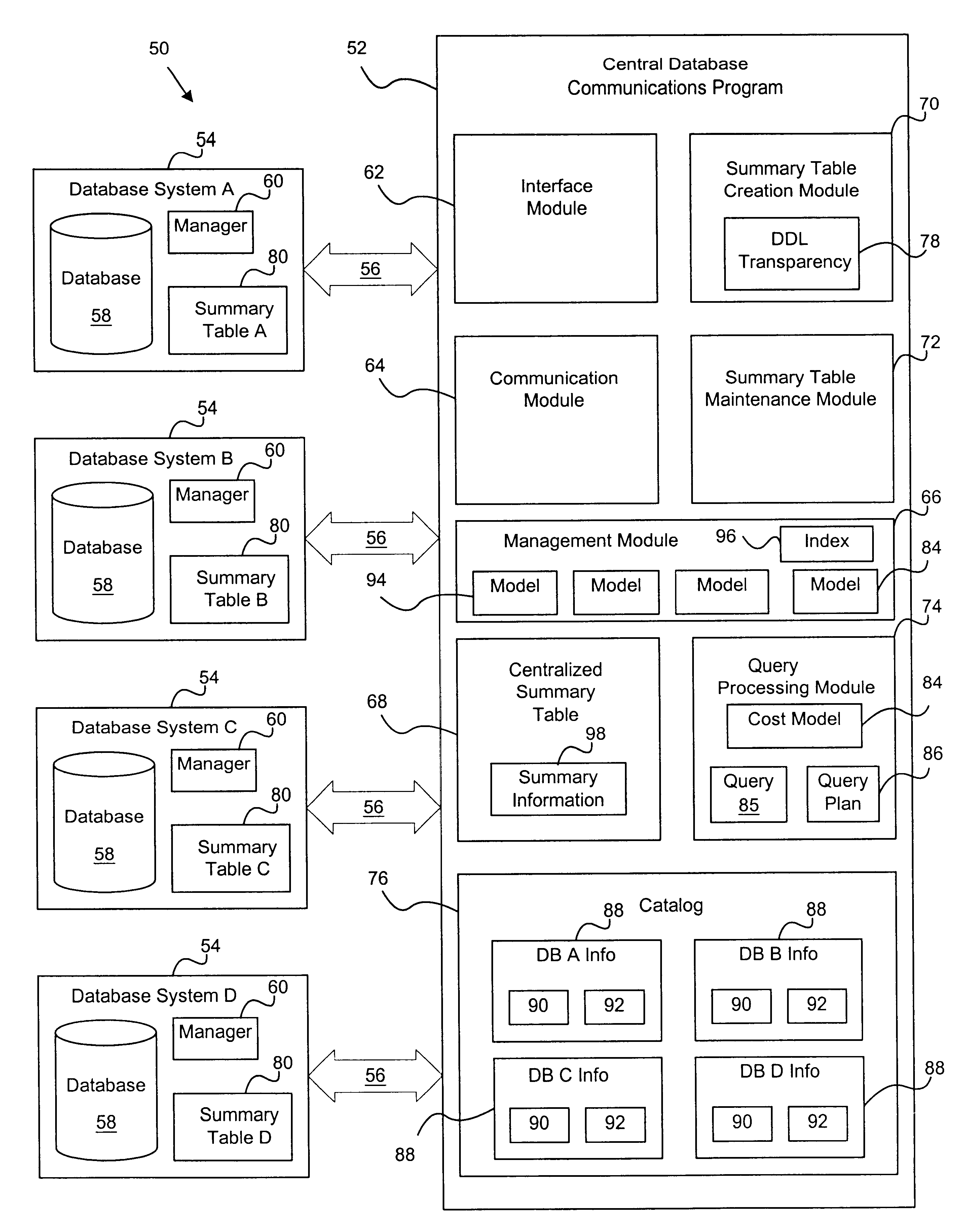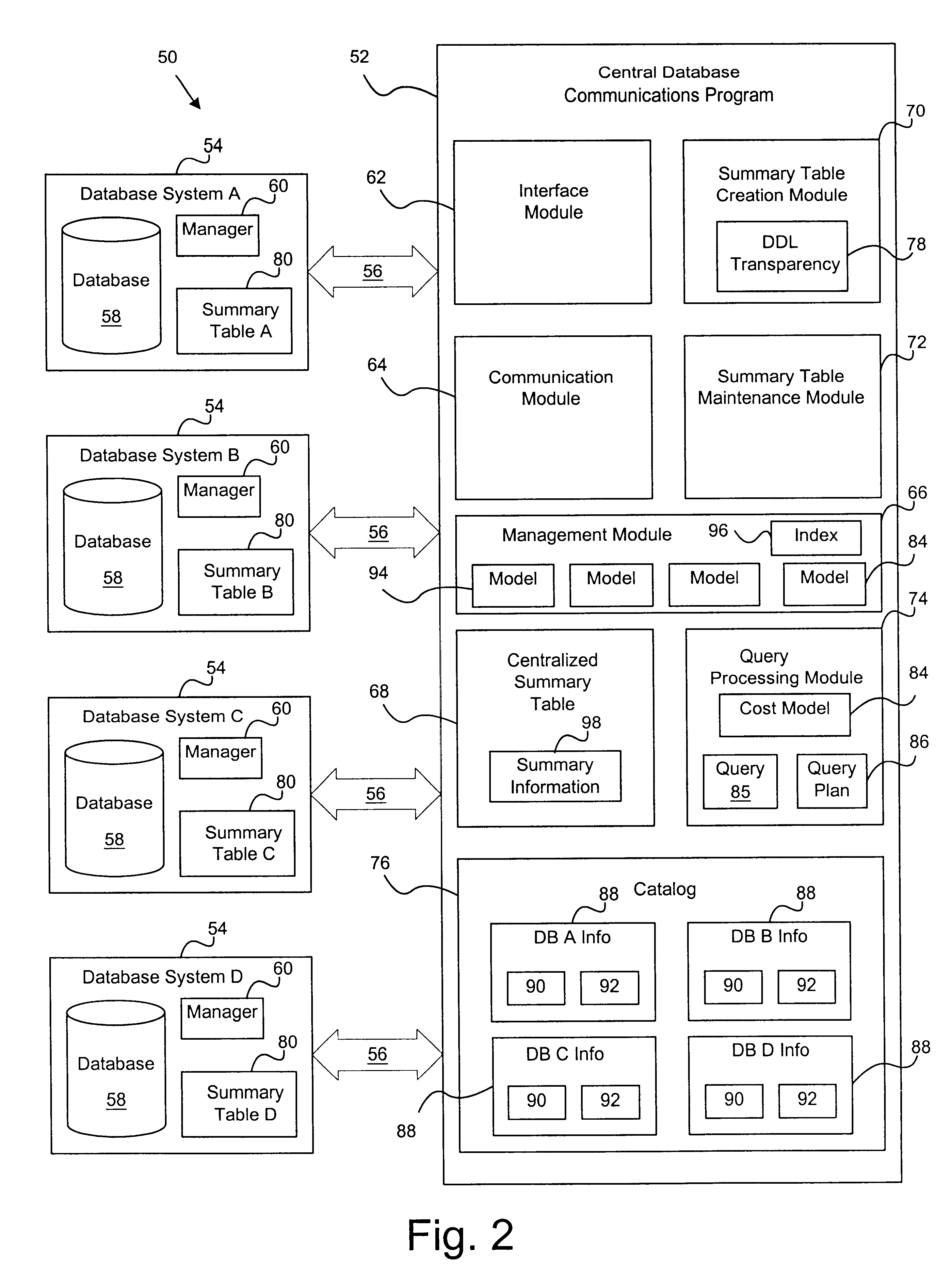Support for summary tables in a heterogeneous database environment
a database environment and database technology, applied in the field of support for summary tables in a heterogeneous database environment, can solve problems such as the inability of database systems to support summary tables
- Summary
- Abstract
- Description
- Claims
- Application Information
AI Technical Summary
Benefits of technology
Problems solved by technology
Method used
Image
Examples
example 2.0
The transformed query 85 may then be incorporated within the query plan 86 or transmitted directly to the relevant database system(s). In this manner, the central program 52 is able to utilize summary tables summarizing communicating database systems 54, regardless of whether any particular remote database system 54 supports and optimizes queries using summary tables.
At a step 184, the results are returned to the central program 52 and displayed on a display device for a user. At a step 186, the method 170 ends.
Examples of varying arrangements in which summary tables may be created, maintained, and queried under the present invention are given in the following examples.
In one example, one or more centralized summary tables 68 are created locally on the central program 52. The summary tables 68 are initially populated locally.
Maintenance is local and may be either incremental or deferred or no maintenance may be conducted. Queries to the summary tables are locally rewritten and optim...
example 3.1
In a second example, one or more summary tables are generated as centralized summary tables 68 locally on the central program 52. The tables 68 are initially populated.
Maintenance is local and may be either incremental or deferred or no maintenance may be conducted. Queries are not routed from the central program to the summary tables 68. Thus, these summary tables 68 are primarily useful for replicating and storing information. Users may choose to route queries directly against the summary table without passing through the query processing module 74.
A sample DDL command for creating a summary table under this example is as follows:
CREATE SUMMARY TABLE SUM1 AS
(SELECT SUM(L_EXTENDEDPRICE) AS REVENUE, P_BRAND,
COUNT(*) AS COUNT
FROM ORACLE_LINEITEM, SYBASE_PART
WHERE P_PARTKEY=L_PARTKEY
GROUP BY P_BRAND)
DATA INITIALLY DEFERRED REFRESH DEFERRED ROUTING NONE;
This DDL command is the same as for Example 3.1, with the exception that no queries are routed to the summary table 68.
example 3.2
In a third example, one or more summary tables are generated remotely on one or more of the database systems 54. The tables 80 are initially populated either locally from the central program 52 or remotely from the database systems 54.
Maintenance is conducted remotely by the hosting database system 54 and may be incremental or deferred or may not be conducted at all. Queries on the base tables are routed to the remote hosting database 52 which in turn routes the queries 85 to the summary table(s) 80. Alternatively, queries may not be routed to the summary tables 80 at all.
Examples of this arrangement include situations where the hosting database system 54 supports summary tables and the description of the summary table 80 is exposed to the user at the central program 52 without performing any query routing.
A sample DDL command for creating a summary table under this example is as follows:
CREATE NICKNAME ORA_SUM1 ON ORACLE.J15USER1.ORA_SUM1;
ALTER NICKNAME ORA_SUM1 SET SUMMARY AS
(SELE...
PUM
 Login to View More
Login to View More Abstract
Description
Claims
Application Information
 Login to View More
Login to View More - R&D
- Intellectual Property
- Life Sciences
- Materials
- Tech Scout
- Unparalleled Data Quality
- Higher Quality Content
- 60% Fewer Hallucinations
Browse by: Latest US Patents, China's latest patents, Technical Efficacy Thesaurus, Application Domain, Technology Topic, Popular Technical Reports.
© 2025 PatSnap. All rights reserved.Legal|Privacy policy|Modern Slavery Act Transparency Statement|Sitemap|About US| Contact US: help@patsnap.com



